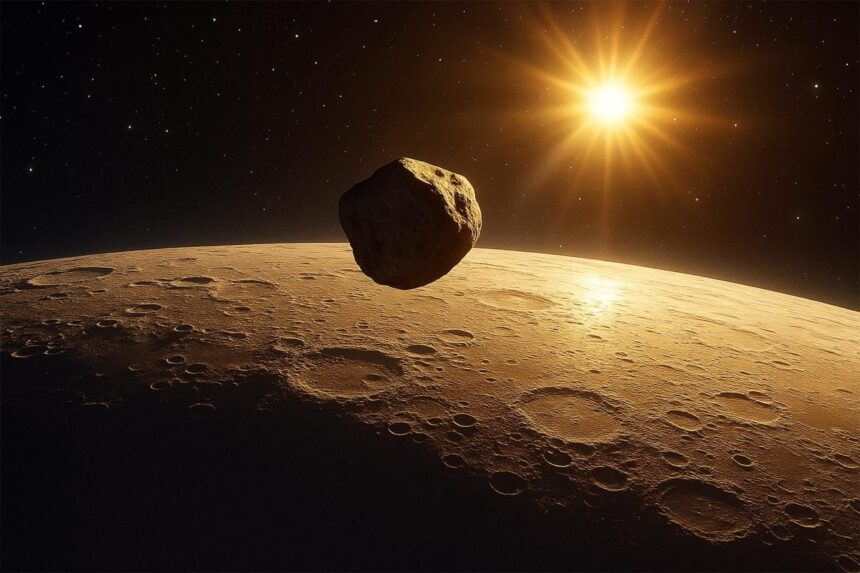A Wake-Up Call From Space: New James Webb Telescope Data Warns of Potential Lunar Collision
In a development that has stirred intense interest among astronomers and planetary defense experts alike, new data from NASA’s James Webb Space Telescope (JWST) has significantly increased the odds that asteroid 2024 YR4 could collide with the Moon in 2032. While Earth remains out of immediate danger, the prospect of a “city-killer” asteroid impacting our lunar neighbor is forcing scientists to reassess both near-Earth object (NEO) monitoring and the long-term strategies of planetary defense.
The asteroid, first detected in late 2024 by a ground-based observatory in Chile, was initially categorized as a “potentially hazardous object” due to its size and orbit. But it wasn’t until recent observations by the James Webb Telescope, orbiting nearly a million miles from Earth, that researchers were able to refine the object’s trajectory with greater accuracy.
According to updated projections released by NASA and the European Space Agency (ESA), the probability of 2024 YR4 striking the Moon within the next decade has risen sharply—from an initial estimate of 0.1% to nearly 7%, with further increases not ruled out as calculations continue.
The Power of James Webb’s Precision
Launched in December 2021, the James Webb Space Telescope was designed primarily for deep-space observation—peering into the early universe and analyzing the atmospheres of exoplanets. Yet its unprecedented precision is proving to be a game-changer in more immediate, practical domains—especially in tracking objects within our own solar system.
By observing 2024 YR4 in the infrared spectrum, Webb has provided the most detailed data yet on the asteroid’s shape, mass, spin, and orbital characteristics. Combined with radar imaging and optical data from ground-based telescopes, scientists now have a much clearer picture of how the asteroid is behaving in space.
“Webb has turned out to be an unexpectedly powerful tool for tracking solar system dynamics,” said Dr. Lydia Mancini, a planetary scientist at the University of Arizona. “We’re not just looking at stars light-years away—we’re safeguarding our own celestial backyard.”
What We Know About Asteroid 2024 YR4
Measuring approximately 320 meters in diameter, 2024 YR4 is large enough to cause catastrophic regional damage were it to hit Earth. Its classification as a “city-killer” is based on models that predict the energy release of such an impact could be equivalent to multiple nuclear bombs.
While its current orbital path rules out a direct Earth strike in the foreseeable future, the Moon—our closest celestial neighbor—has emerged as a potential target due to a slight gravitational nudge identified in its last solar flyby. The updated trajectory suggests a close approach to the Moon sometime in late 2032, with a possible impact window between November and December of that year.
If a collision occurs, it would mark the most significant extraterrestrial impact event observed by humans in real time.
The Science—and Risks—of a Lunar Impact
Unlike Earth, the Moon lacks an atmosphere, which means asteroids don’t burn up upon entry. Any collision with an object the size of 2024 YR4 would result in the formation of a new crater, potentially dozens of kilometers wide. The kinetic energy unleashed would eject vast quantities of lunar material into space, some of which could fall back to the Moon, while smaller debris might enter Earth’s vicinity.
There’s no threat of global devastation, but scientists are concerned about the cascading effects on lunar exploration infrastructure. Several nations, including the United States, China, and India, have ongoing and upcoming missions targeting the Moon in the 2030s, including manned bases, rovers, and telescopic observatories.
“If the asteroid lands near an area of scientific or logistical interest, the consequences could be considerable,” said Dr. Michael Lee of NASA’s Near-Earth Object Program. “We’re not just talking about a rock hitting a dead rock—we’re talking about safeguarding our investment in space exploration.”
Monitoring, Mitigating, and Mobilizing
While the impact risk is limited to the Moon, the event is prompting renewed discussions on how humanity should prepare for more serious threats closer to home. The incident serves as a test case for coordination between space agencies, astronomers, and defense organizations.
Currently, missions like NASA’s DART (Double Asteroid Redirection Test) and ESA’s upcoming Hera mission are exploring how to deflect or alter the course of dangerous asteroids. But these systems are still experimental, and few are prepared to address an object as large as 2024 YR4 on short notice.
Some have floated the idea of redirecting the asteroid deliberately away from the Moon, although doing so would be technically complex and fraught with risk. Others suggest using the opportunity to study a large-scale impact in real time—perhaps even deploying landers or satellites to monitor the event.
Public Perception and the Broader Significance
Although the asteroid poses no direct threat to human life, the story has captivated public attention. Social media is already abuzz with speculation, ranging from genuine scientific curiosity to apocalyptic conspiracy theories. Scientists caution against panic but support broader public engagement in understanding space risks.
“This is a rare opportunity to educate the public on why planetary defense matters,” said Dr. Roshan Patel, an astrophysicist at ESA. “The Moon is taking a hit for us, so to speak. That should be a wake-up call.”
The event also underscores the value of investment in space infrastructure. Tools like the James Webb Space Telescope, once seen as luxury instruments for pure research, are proving indispensable in the practical business of safeguarding Earth and its environs.
Looking Ahead: A Decade of Preparation and Observation
The projected impact date is still nearly eight years away, giving scientists time to observe, plan, and possibly act. With each passing month, the orbital data will become more refined, and predictions more precise.
In the meantime, space agencies are expected to increase tracking efforts, run simulations, and possibly begin developing dedicated instruments to observe the Moon in unprecedented detail before, during, and after the potential event.
Whether or not 2024 YR4 ultimately collides with the Moon, the conversation it has sparked is vital. It reminds humanity that we exist in a cosmic arena where celestial events, once considered purely academic, can have real and far-reaching consequences.
Conclusion: A Harmless Impact with Heavy Implications
As James Webb’s keen eyes continue to scan the skies, asteroid 2024 YR4 has emerged as a vivid reminder of the universe’s unpredictable dynamics. Though the threat is directed at the Moon and not Earth, the scenario has awakened interest in our fragile planetary situation and the tools we use to protect it.
It is a moment to reflect not only on the progress we’ve made in understanding space but on the steps still needed to ensure that when the next asteroid comes knocking, we are ready—not with fear, but with foresight.






